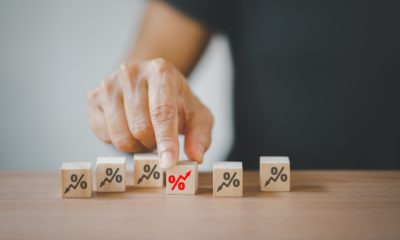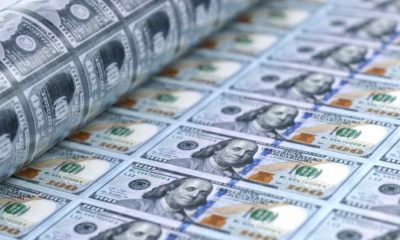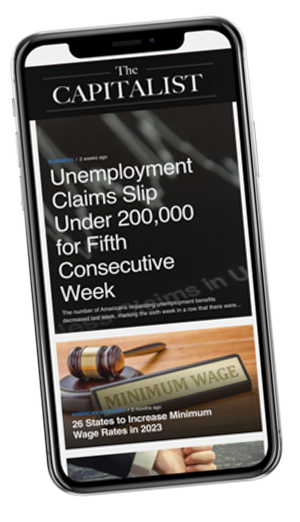Business
Crexit: Corporate Debt Set To Balloon
Following the Brexit vote, jokes abounded of possible Departugal, Czechout, Italeave, Oustria, Byegium, and several other countries name-based puns.
Funny stuff, but the latest portmanteau is far from a laughing matter: read on for analysts’ fears of Crexit, the result of ballooning corporate debt and the risks it poses.
The current situation and how it could be managed
Corporate debt is the housing market crisis of its day.
The figure is projected to balloon over the next few years, due to various factors.
One of the most important of these is that Central Banks throughout the world are toying with zero or negative interest rates.
This provides cheap money to make the rounds, and the debt is piling up.

A report earlier this week has warned that this debt pileup has the potential to spark a new crisis from all that borrowed money circulating in the economy.
The figures are astronomical and growing all the time.
By the year 2020, several things will have occurred.
Britain’s socialist opposition leader will have proven his credentials or flunked like everyone predicted.
The Kyoto Protocols aimed at 2020 will have been achieved or failed.
Portugal will have lost or retained the European Championship.
And business debt will probably climb from the $51 trillion it is currently at to $75 trillion.
This is according to our friends at S&P Global Ratings, who tend to be right about this stuff.
They track the eponymously named 500 companies’ index which is a good barometer of the economy.
Of course, $51 trillion is already a huge amount.
But the thing about debt is it’s perfectly manageable as long as:
The quality of credit stays high
– Interest rates remain low as they currently are (which is why the Fed raising was such a huge event)
– Inflation remains low
– Economic growth remains high so that investors don’t worry about not getting paid
[ms_divider style=”normal” align=”left” width=”100%” margin_top=”30″ margin_bottom=”30″ border_size=”5″ border_color=”#f2f2f2″ icon=”” class=”” id=””][/ms_divider]
[ms_featurebox style=”4″ title_font_size=”18″ title_color=”#2b2b2b” icon_circle=”no” icon_size=”46″ title=”Recommended Link” icon=”” alignment=”left” icon_animation_type=”” icon_color=”” icon_background_color=”” icon_border_color=”” icon_border_width=”0″ flip_icon=”none” spinning_icon=”no” icon_image=”” icon_image_width=”0″ icon_image_height=”” link_url=”https://offers.thecapitalist.com/p/warrenbuffet/index” link_target=”_blank” link_text=”Click Here To Find Out What It Said…” link_color=”#4885bf” content_color=”” content_box_background_color=”” class=”” id=””]Warren Buffett Just Told His Heirs What He Wants them To Do With His Fortune When He Dies. [/ms_featurebox]
[ms_divider style=”normal” align=”left” width=”100%” margin_top=”30″ margin_bottom=”30″ border_size=”5″ border_color=”#f2f2f2″ icon=”” class=”” id=””][/ms_divider]
Assuming things don’t go so swimmingly
But should things not go exactly according to this plan, there is another scenario, from where we get our horribly unimaginative and lazy portmanteau, crexit.
Should interest rates rise, which they could, and economic conditions worsen, which they might, there could be a huge problem for corporate America when trying to manage its debt.
Interest rate rises will make it harder to borrow money.
Worsening economic conditions are a huge fear now that Britain is almost certain to leave the European Single market, in some way, shape or form.
A bad global economy, let alone a sad one, would scare investors into thinking they won’t get paid, and country’s credit ratings will be slashed, making it harder for them to borrow.
Mostly, bondholders would suffer because rolling bonds over would become increasingly difficult under increased inflation and an interest rate rise.
The economy worsening would hurt businesses’ ability to pay off the debt.
A combination of these two leads to all sorts of problems for all parties.
If it did occur, we could see a crexit.
A credit-exit.
This would be lenders withdrawing from credit markets due to fears of the economy and covering their costs.
If it occurred, it would lead to a drastic tightening of market conditions.
This has the potential to cause another financial meltdown, and the world simply cannot deal with that, economically, politically or socially.
Worst Case Scenario
In the report, S&P Global said that the nightmare scenario would be a series of high-risk, high-cost negative surprises that prove to be the spark for a new crisis of confidence.
Confidence in the world economy is already at an all-time low because of how long and profound the last recession was.

Add to that the slowing China economy and Britain’s decision to leave the European Union; you have salt in the wounds that now mean the world economy is at its most fragile.
Confidence is low, and it can’t afford to get any lower.
If events opposite to those listed in the bullet points, or any major economic events that no one can foresee happen, it will be destabilizing.
– Investors will feel pushed to exit their risky positions where they fear that they are going to lose big money.
– If swarm effect holds genuine and they all go in the same direction, this will see a collapse in credit growth.
– And the last time that happened? 2008
What is inevitable and what is potential
Many, S&P included, believe that a ‘correction,' industry speaks for a significant collapse and readjustment, to be almost inevitable.
They see it as inevitable at some point in the next decade, and the real million-dollar question is to what extent they will be right.
Not whether it will happen, but how much.
They worry that investors have been too hungry for yield and have ended up going on a frenzy of buying speculative, low-grade corporate debt.
China has been as guilty as the United States in this regard, the former having used the borrowing tool to spur growth in the face of a slowing economy.
Its growth is still astronomical compared to Western economies, but it is decreasing each year.
Remember in the housing crisis (see graph below) when it was found out that mortgage bonds were weak structurally and pyramids made up of speculative and non-existent deals made the whole thing come crashing down?
This is a little similar, except now its corporate debt rather than mortgages.

The blame for much of this lies at the feet of the world’s central banks.
Since the crisis, they have embarked on a policy of low-interest rates and cheap money as a spur to economic growth.
The problem with this is the notion that growth fueled by credit rather than innovation and investment is healthy is an entirely false one.
The global economy needs real growth, not one made out of printed bills.
Monetary policy by said central banks has increased the financial risk that the world faces, the opposite effect that it was meant to have.
After uncertainty about growth during the crisis, central banks wanted to give the economy a jolt to restore confidence and stability.
But it has done the opposite.
The problem is that corporate borrowing is shooting way ahead of global economic growth.
And who can blame them when credit is so cheap with interests rate set so low?
More debt? Don’t fret
Even in the face of this impending crisis with sky-high debt levels, central banks are too terrified to put the brakes on to their policy of low rates.
Interest rates are low from Tokyo to Texas, from London to Lagos, Moscow to Medellin (okay maybe not exactly in all those places but you get the picture).

The low-interest rates have caused a boom in not only corporate debt but government debt too.
$12 trillion of government bonds now carry negative yields.
That means investors aren’t getting anything back from buying government bonds.
Debt flow is predicted to grow by over $60 trillion by 2020.
– Two-thirds of this are expected to be in refinancing (so just managing current debt).
– The remaining one-third will be in a brand spanking new debt. Shiny, shimmering debt.
– This will include bonds, loans, and any other financial instruments.
– This projection has increased from that of under $60 trillion that was given by S&P some time ago.
Best case scenario
While the debt market is reaching its upper limits, S&P and others are hoping for an orderly drawdown.
A gradual scaling back of current policy of low-interest rates and cheap money for more sound future finances.
This is the best case scenario, but it will be difficult to become a reality.
Firstly, things like Brexit will unnerve world leaders.
The most important political events such as the high vote throw a spanner in the works and a change to the status quo of the last 40 years is bound to cause some paranoid visions of what its result will be.
Nervous leaders are prone to pulling back from giving cheap credit to higher-risk borrowers.
Debt is piling up in China’s somewhat opaque but robustly expanding corporate sector, and there is also growing debt in the United States’ leveraged finance sector.
The risk is in credit quality.
‘Highly leveraged’ is a term applied to around half of companies that are outside the financial sector.
This category is the lowest one available for risk, and about 5% of this category group have negative earnings or negative cash flows.
In 2016 so far, there have been 100 debt defaults.
This is the most for this period in the year since the financial crisis.
Worrying signs.
S&P and other firms are worried that investors who have tried to play a long game and bought bonds with long-term caveats are at risk.
They have done so to chase high yield, but the risk is that they will lose money and pull out of the market to play it safe.
Unfettered funding of debt has created conditions for elevated prices of financial assets.
Low-interest rates have added to this factor and increased the effect.
Investors are searching for yield, and financial assets are seeing augmented prices because of it.
Market volatility could increase over the next few years because of this.
Small secondary-market cash flow and liquidity will lead to credit spreads for even riskier securities and longer contracted assets being the most exposed.
China will be responsible for most credit flow growth.
The nation is predicted to add almost $30 trillion to global demand, while the US and Europe will add $14 and $9 trillion respectively.















